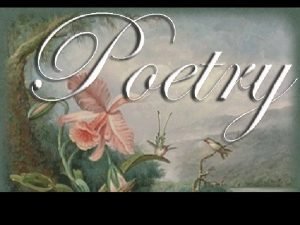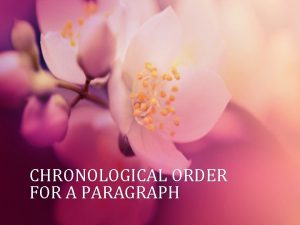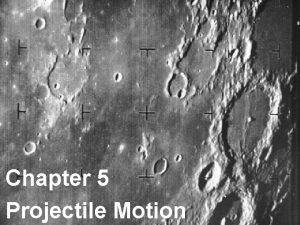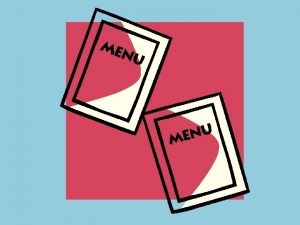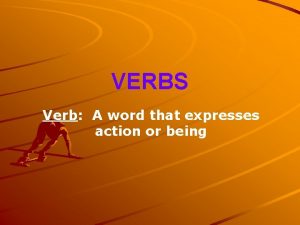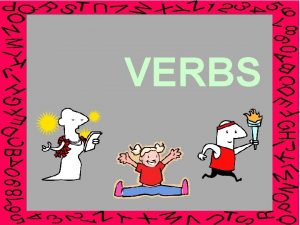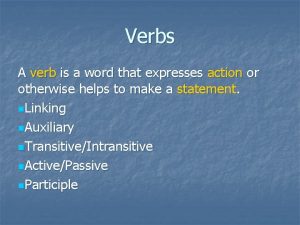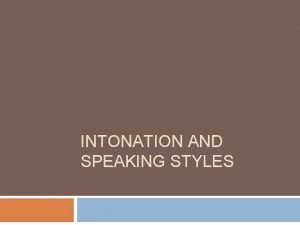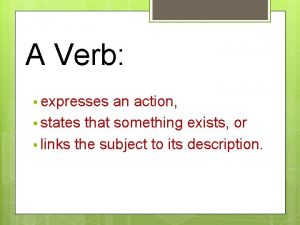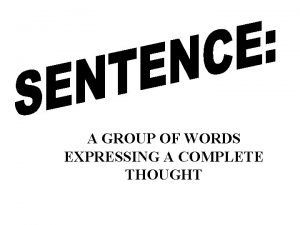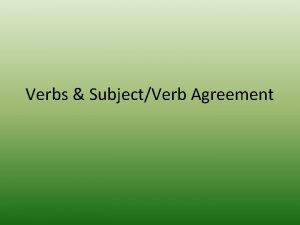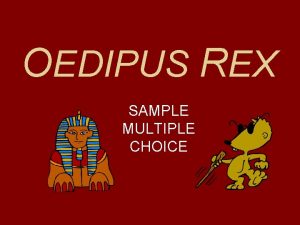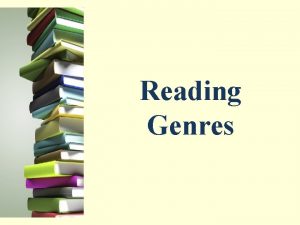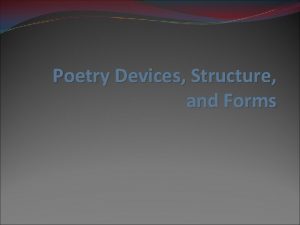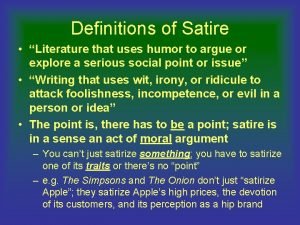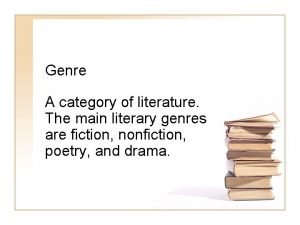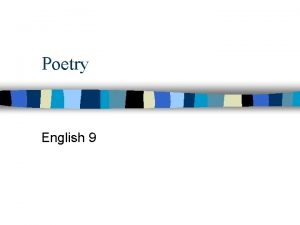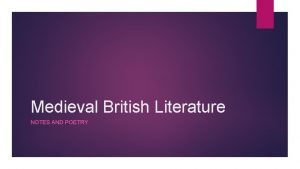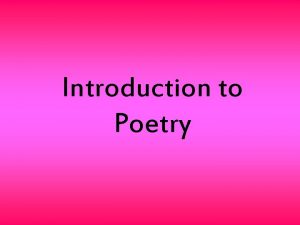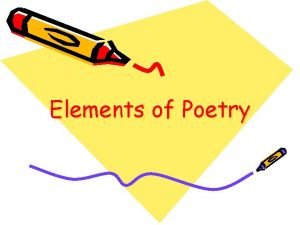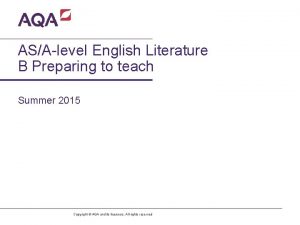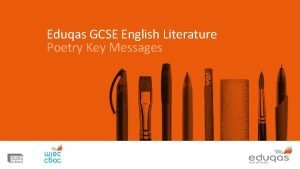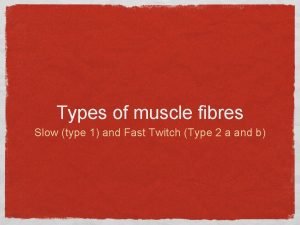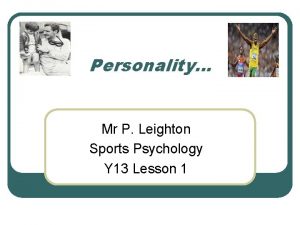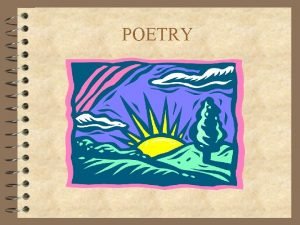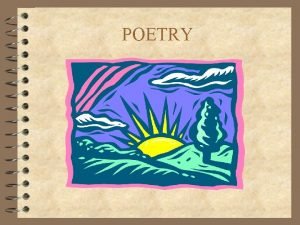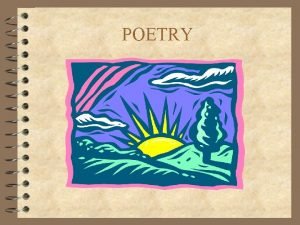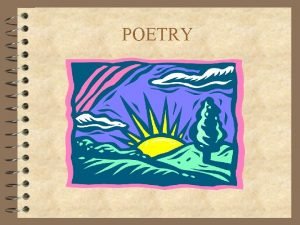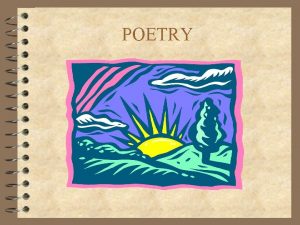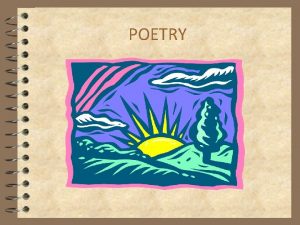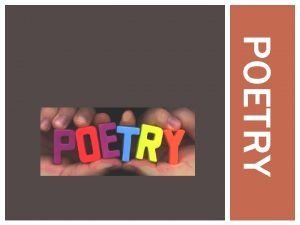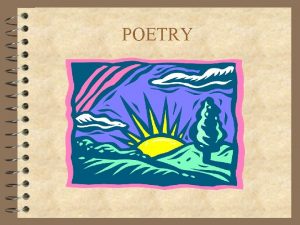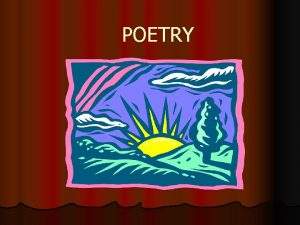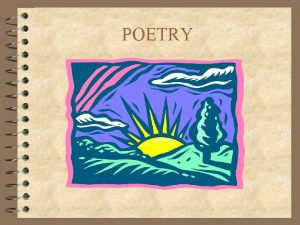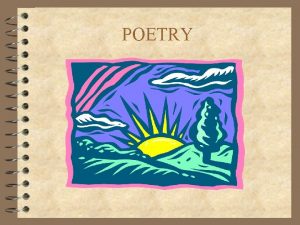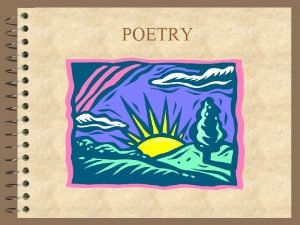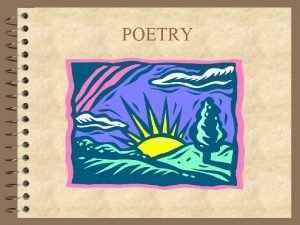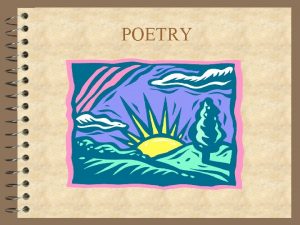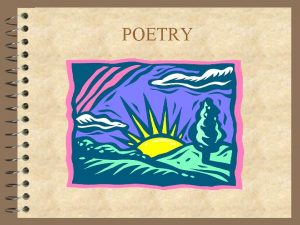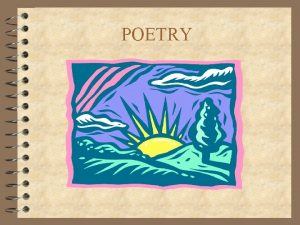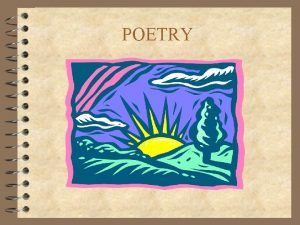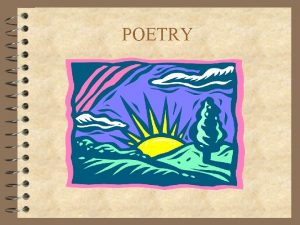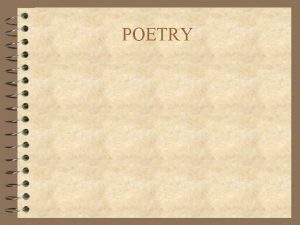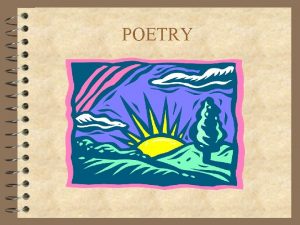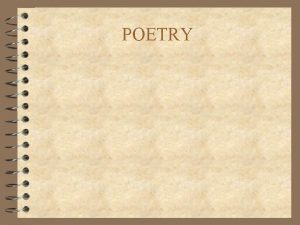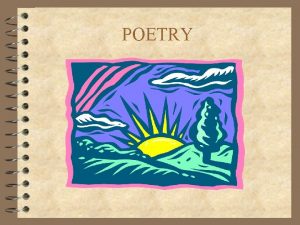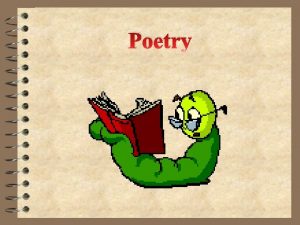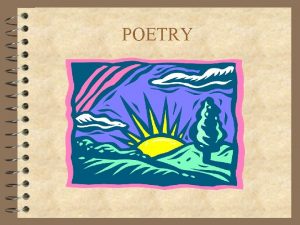POETRY POETRY A type of literature that expresses











































- Slides: 43

POETRY

POETRY Ø A type of literature that expresses ideas, feelings, or tells a story in a specific form (usually using lines and stanzas)

POINT OF VIEW IN POETRY POET SPEAKER 4 The poet is the author 4 The speaker of the poem is the “narrator” of the poem. 4 Poet=Author 4 Speaker=Narrator

POETRY STRUCTURE 4 FORM - the appearance of the words on the page A word is dead When it is said, Some say. 4 LINE - a group of words together on one line of the poem 4 STANZA - a group of lines arranged together I say it just Begins to live That day.

KINDS OF STANZAS Couplet Triplet (Tercet) Quatrain Quintet Sestet (Sextet) Septet Octave = = = = a two line stanza a three line stanza a four line stanza a five line stanza a six line stanza a seven line stanza an eight line stanza

Tone is the attitudes toward Examples of Tone the subject and toward the 4 Syntax (the arrangement audience implied in the of words), work. 4 Diction (choice of words and style of expression) Tone may be formal, 4 Imagery (descriptive informal, intimate, solemn, words that serve as a way for the reader to see what somber, playful, serious, is written) ironic, condescending, or many other possible 4 Details and Figurative attitudes. Language

SOUND EFFECTS

RHYTHM 4 The beat created by the sounds of the words in a poem 4 Rhythm can be created by meter, rhyme, alliteration and refrain.

RHYME 4 Words sound alike because they share the same ending vowel and consonant sounds. 4 (A word always rhymes with itself. ) LAMP STAMP á Share the short “a” vowel sound á Share the combined “mp” consonant sound

INTERNAL RHYME 4 A word inside a line rhymes with another word on the same line. Once upon a midnight dreary, while I pondered weak and weary. From “The Raven” by Edgar Allan Poe

END RHYME 4 A word at the end of one line rhymes with a word at the end of another line Hector the Collector Collected bits of string. Collected dolls with broken heads And rusty bells that would not ring.

RHYME SCHEME 4 A rhyme scheme is a pattern of rhyme (usually end rhyme, but not always). 4 Use the letters of the alphabet to represent sounds to be able to visually “see” the pattern. (See next slide for an example. )

SAMPLE RHYME SCHEME The Germ by Ogden Nash A mighty creature is the germ, Though smaller than the pachyderm. His customary dwelling place Is deep within the human race. His childish pride he often pleases By giving people strange diseases. Do you, my poppet, feel infirm? You probably contain a germ. a a b b c c a a

REFRAIN 4 A sound, word, phrase or line repeated regularly in a poem. “Quoth the raven, ‘Nevermore. ’”

ONOMATOPOEIA 4 Words that imitate the sound they are naming BUZZ 4 OR sounds that imitate another sound “The silken, sad, uncertain, rustling of each purple curtain. . . ”

ALLITERATION 4 Consonant sounds repeated at the beginnings of words If Peter Piper picked a peck of pickled peppers, how many pickled peppers did Peter Piper pick?

CONSONANCE 4 Similar to alliteration EXCEPT. . . 4 The repeated consonant sounds can be anywhere in the words “silken, sad, uncertain, rustling. . “

ASSONANCE 4 Repeated VOWEL sounds in a line or lines of poetry. (Often creates near rhyme. ) Lake Fate Base Fade (All share the long “a” sound. )

ASSONANCE cont. Examples of ASSONANCE: “Slow the low gradual moan came in the snowing. ” - John Masefield “Shall ever medicine thee to that sweet sleep. ” - William Shakespeare

TYPES OF POETRY

Soliloquy 4 The act of talking to oneself; a dramatic monologue that represents a series of unspoken reflections 4 Typically applied to theatrical characters engaged in a monologue, but it can also be used as a term in a literary work that simply describes an occurrence when a character talks with him/her/itself. (The character realizes things he/she/it would not have realized if not verbalized aloud. )

BLANK VERSE POETRY from Julius Ceasar 4 Written in lines of iambic pentameter, but does NOT use end rhyme. Cowards die many times before their deaths; The valiant never taste of death but once. Of all the wonders that I yet have heard, It seems to me most strange that men should fear; Seeing that death, a necessary end, Will come when it will come.

LYRIC 4 A short poem 4 Usually written in first person point of view 4 Expresses an emotion or an idea or describes a scene 4 often musical 4 (Many of the poems we read will be lyrics. )

HAIKU A Japanese poem written in three lines Five Syllables Seven Syllables Five Syllables An old silent pond. . . A frog jumps into the pond. Splash! Silence again.

CINQUAIN A five line poem containing 22 syllables Two Syllables Four Syllables Six Syllables Eight Syllables Two Syllables How frail Above the bulk Of crashing water hangs Autumnal, evanescent, wan The moon.

FREE VERSE POETRY 4 Unlike metered poetry, 4 Free verse poetry is free verse poetry does very conversational NOT have any sounds like someone repeating patterns of talking with you. stressed and unstressed syllables. 4 A more modern type 4 Does NOT have to of poetry. rhyme.

SHAKESPEAREAN SONNET A fourteen line poem with a specific rhyme scheme. The poem is written in three quatrains and ends with a couplet. The rhyme scheme is abab cdcd efef gg Shall I compare thee to a summer’s day? Thou art more lovely and more temperate. Rough winds do shake the darling buds of May, And summer’s lease hath all too short a date. Sometimes too hot the eye of heaven shines, And often is his gold complexion dimmed; And every fair from fair sometimes declines, By chance or nature’s changing course untrimmed. But thy eternal summer shall not fade Nor lose possession of that fair thou ow’st; Nor shall Death brag thou wanderest in his shade, When in eternal lines to time thou grow’st So long as men can breathe or eyes can see, So long lives this, and this gives life to thee.

NARRATIVE POEMS 4 A poem that tells a story and establishes characters and plot. 4 Generally longer than the lyric styles. Examples of Narrative Poems “The Raven” “The Highwayman” “Casey at the Bat” “The Walrus and the Carpenter”

CONCRETE POEMS 4 In concrete poems, the words are arranged to create a picture that relates to the content of the poem. Poetry Is like Flames, Which are Swift and elusive Dodging realization Sparks, like words on the Paper, leap and dance in the Flickering firelight. The fiery Tongues, formless and shifting Shapes, tease the imiagination. Yet for those who see, Through their mind’s Eye, they burn Up the page.

Acrostic A poem that uses the letters of a word to create the poem; the first letter is usually the beginning of each line. Ex. Pepperoni In my mouth—it’s hot! Zap in the oven Zing! Appetizing Ex. Perfectly able to get Out your feelings, Easy to write, so many Types; take your pick. Really, it’s a great outlet for Your talents.

FIGURATIVE LANGUAGE

SIMILE 4 A comparison of two things using “like, as than, ” or “resembles. ” 4 “She is as beautiful as a sunrise. ”

METAPHOR 4 A direct comparison of two unlike things 4 “All the world’s a stage, and we are merely players. ” - William Shakespeare

EXTENDED METAPHOR 4 A metaphor that goes several lines or possible the entire length of a work.

IMPLIED METAPHOR 4 The comparison is hinted at but not clearly stated. 4 “The poison sacs of the town began to manufacture venom, and the town swelled and puffed with the pressure of it. ” - from The Pearl - by John Steinbeck

Hyperbole 4 Exaggeration often used for emphasis. Example: I am so hungry I could eat a horse!

Litotes 4 Understatement - basically the opposite of hyperbole. Often it is ironic. 4 Ex. Calling a slow moving person “Speedy”

Idiom 4 An expression where the literal meaning of the words is not the meaning of the expression. It means something other than what it actually says. 4 Ex. It’s raining cats and dogs.

PERSONIFICATION 4 An animal given humanlike qualities or an object given life-like qualities. from “Ninki” by Shirley Jackson “Ninki was by this time irritated beyond belief by the general air of incompetence exhibited in the kitchen, and she went into the living room and got Shax, who is extraordinarily lazy and never catches his own chipmunks, but who is, at least, a cat, and preferable, Ninki saw clearly, to a man with a gun.

OTHER POETIC DEVICES

SYMBOLISM 4 When a person, place, thing, or event that has meaning in itself also represents, or stands for, something else. = Innocence = America = Peace

Allusion 4 Allusion comes from the verb “allude” which means “to refer to” 4 An allusion is a reference to something famous. A tunnel walled and overlaid With dazzling crystal: we had read Of rare Aladdin’s wondrous cave, And to our own his name we gave. From “Snowbound” John Greenleaf Whittier

IMAGERY 4 Language that appeals to the senses. 4 Most images are visual, but they can also appeal to the senses of sound, touch, taste, or smell. then with cracked hands that ached from labor in the weekday weather. . . from “Those Winter Sundays”
 Block nhĩ thất cao độ
Block nhĩ thất cao độ Phân độ lown
Phân độ lown Thơ thất ngôn tứ tuyệt đường luật
Thơ thất ngôn tứ tuyệt đường luật Thơ thất ngôn tứ tuyệt đường luật
Thơ thất ngôn tứ tuyệt đường luật Chiến lược kinh doanh quốc tế của walmart
Chiến lược kinh doanh quốc tế của walmart Tìm vết của đường thẳng
Tìm vết của đường thẳng Con hãy đưa tay khi thấy người vấp ngã
Con hãy đưa tay khi thấy người vấp ngã Tôn thất thuyết là ai
Tôn thất thuyết là ai Gây tê cơ vuông thắt lưng
Gây tê cơ vuông thắt lưng Sau thất bại ở hồ điển triệt
Sau thất bại ở hồ điển triệt Poem about julius caesar
Poem about julius caesar Chronological example paragraph
Chronological example paragraph When no air resistance acts on a projectile
When no air resistance acts on a projectile The menu expresses the concept and theme through
The menu expresses the concept and theme through Word that expresses action or being *
Word that expresses action or being * Expresses action
Expresses action Verb with n
Verb with n The designer expresses the ideas in terms related to the
The designer expresses the ideas in terms related to the Fall intonation
Fall intonation What expresses an action
What expresses an action Group of words expresses a complete thought
Group of words expresses a complete thought A verb expresses
A verb expresses Tense exercises with answers
Tense exercises with answers Language processor mcq
Language processor mcq Oedipus rex ap multiple choice questions
Oedipus rex ap multiple choice questions Reading genres
Reading genres Type of tone in literature
Type of tone in literature What type of literature uses humor
What type of literature uses humor A category or type of literature
A category or type of literature A fourteen line poem with prescribed rhyme of scheme
A fourteen line poem with prescribed rhyme of scheme Medieval poetry in english literature
Medieval poetry in english literature Poetry vs prose
Poetry vs prose Elements and characteristics of poetry
Elements and characteristics of poetry What is poetry in literature
What is poetry in literature Gcse english past papers edexcel
Gcse english past papers edexcel Aqa a level english literature b past papers
Aqa a level english literature b past papers Yesterday poem by patricia pogson
Yesterday poem by patricia pogson Is hyper v type 1 or type 2
Is hyper v type 1 or type 2 Order of recruitment of muscle fiber types
Order of recruitment of muscle fiber types Type 1 error and type 2 error in statistics
Type 1 error and type 2 error in statistics Type 1 error vs type 2 error example
Type 1 error vs type 2 error example How can one type of rock change into another type of rock?
How can one type of rock change into another type of rock? Type a and type b personality theory
Type a and type b personality theory Sublimation psychology
Sublimation psychology










